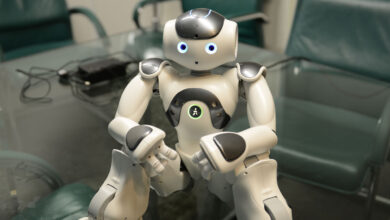Global competition intensifies in humanoid robot market

[Graphics by Song Ji-yoon and Han Yubin]
Global race for human-like robots, known as humanoids, is getting fiercer, as synergy is created between generative artificial intelligence (AI) and robotics.
According to global market research firm Next Move Strategy Consulting (MSC), the worlds AI robot industry is projected to grow from $95.6 billion in 2021 to $158 billion in 2027 and $184.8 billion in 2030, with an annual average growth of over 30 percent.
The market covers industrial, medical, military, and education and research sectors, with intelligent humanoids in the service sector gaining particular attention.
A February report by Goldman Sachs Group Inc. predicted that advancements in AI would make human-like robots the third most dominant technology in history, after electric vehicles and smartphones.
The United States is in the lead.
The U.S. is fostering a robotics ecosystem in Boston, Pittsburgh, and Silicon Valley, with significant government investment in research, development, and manufacturing.
Robotics investment in the U.S. reached $20 billion as of 2021, which accounted for a staggering 60 percent of the investment made across the world.
In March, U.S. robotics startup Figure AI unveiled its humanoid robot, Figure 01. A demonstration video showed the robot holding an apple in hand, picking up trash, and placing a plate on a dish-drying rack while having a simple conversation with a human.
Though seemingly simple, the tasks involve complex cognitive processes, such as natural language comprehension and object recognition, combined with physical actions.
China is also making notable strides in the arena. The competition between the U.S. and China for dominance in the intelligent humanoid robot market is intensifying, with both countries aiming to lead a potential change that could shake traditional labor-intensive sectors such as manufacturing, logistics, military, and security.
In April, Baidu Inc., Chinas largest search engine, unveiled Walker S, an intelligent humanoid robot developed with Chinese robot manufacturer UBTECH Robotics Inc.
Equipped with Baidus large language model (LLM) Ernie 4.0, Walker S can recognize situations and act accordingly. A demonstration video showed Walker S assisting with packing for a business trip, boasting advanced capabilities in task recognition and decision-making.
As part of the trend, big tech leaders are actively developing AI models for robots and investing in robot startups.
Google DeepMind unveiled AutoRT earlier this year. As a system that leverages existing foundation models to scale up the deployment of operational robots in completely unseen scenarios with minimal human supervision, AutoRT combines a video language model (VLM) and LLM to allow robots to understand prompts and perform tasks without advanced programming.
For example, if a user asks for help to cut paper without scissors, the robot can recognize and hand over a nearby stationery knife.
In May, Nvidia Corp. unveiled Eureka, a technology developed with researchers from the University of Pennsylvania and the University of Texas, to accelerate robot training.
Eureka builds on Nvidias AI agent, which generates robot training algorithms. The technology automates training in virtual environments using an LLM before applying it in real-world scenarios.
Nvidia demonstrated Eureka by training a robotic dog, achieving a 34 percent improvement in walking speed.
By Kim Dae-gi and Han Yubin
[ Pulse by Maeil Business News Korea & mk.co.kr, All rights reserved]


